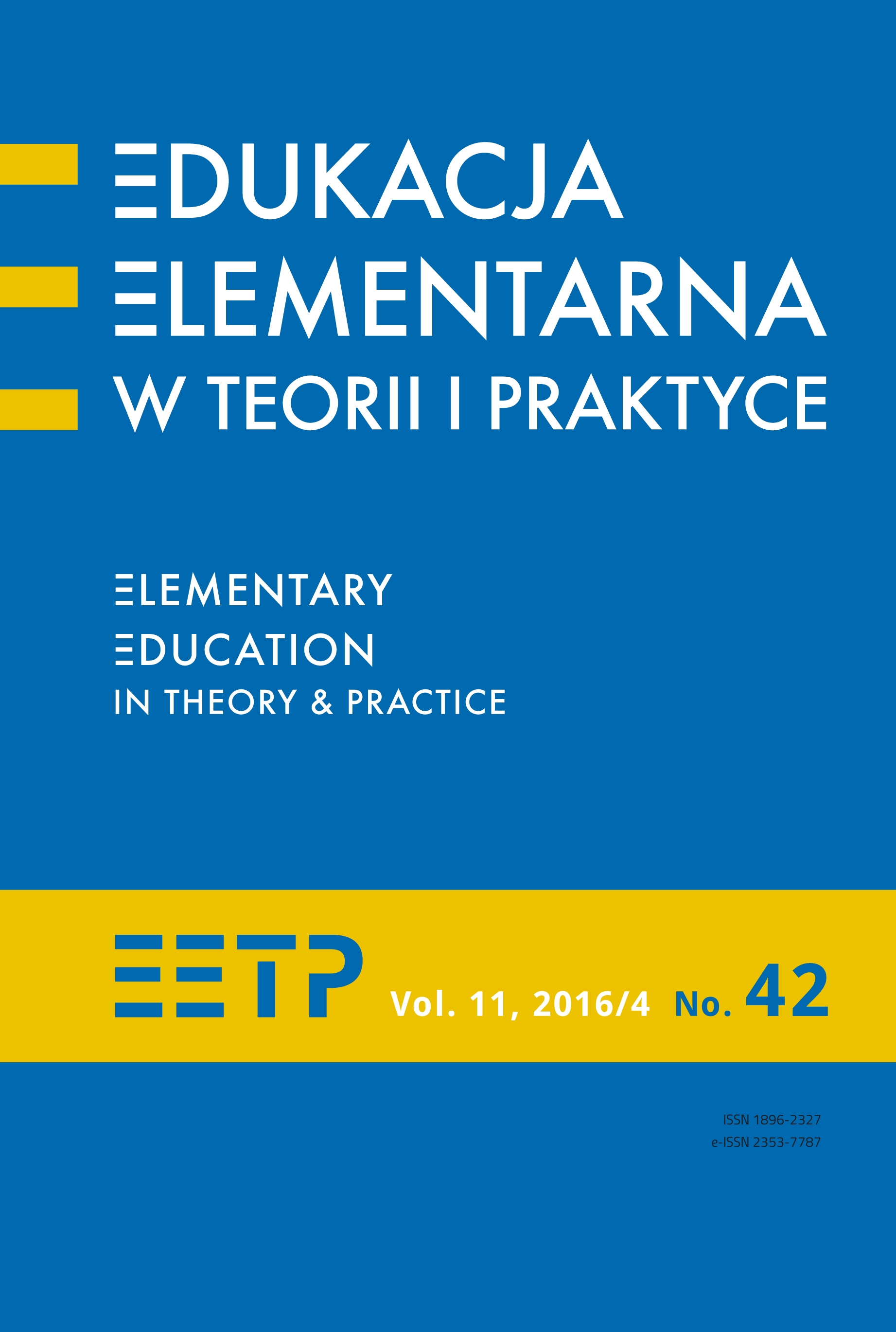Wprowadzanie dziecka w świat współczesnych mediów jako element socjalizacji
Abstrakt
Celem artykułu jest ukazanie znaczenia edukacji medialnej w procesie przygotowania dziecka do funkcjonowania we współczesnej przestrzeni komunikacyjnej i informacyjnej społeczeństwa XXI wieku. Obecnie mass media stanowią jeden z integralnych elementów naszego codziennego otoczenia. Widać to wyraźnie na przykładzie rozwoju mediów cyfrowych, które na przestrzeni ostatnich dekad stały się nieodłączną częścią środowiska, w którym dorasta młody człowiek. W tym kontekście edukacja medialna, zarówno w aspekcie technologicznym, jak i kulturowym, to działanie edukacyjne, zmierzające do wyposażenia dzieci i młodzieży w kompetencje medialne. Dzięki nabytym umiejętnościom wśród dzieci wykształcają się postawy świadomego i krytycznego odbioru mediów, a także racjonalnego posługiwania się nimi jako narzędziami komunikowania się, uczenia i pracy. W artykule zostały wyodrębnione i omówione te obszary edukacji medialnej, które są powiązane z procesem socjalizacji dziecka i wprowadzaniem go w wirtualną przestrzeń społeczną. W ramach oddziaływań wychowawczych zachodzą procesy socjalizacji i inkulturacji, które przygotowują dzieci i młodzież do życia w świecie cyfrowym i ułatwiają im wejście w rzeczywistość społeczną zapośredniczoną przez media. Działania te budują odporność na występujące współcześnie zagrożenia i przez to, przynajmniej częściowo, zapewniają gwarancję bezpieczeństwa.
Bibliografia
Dobrołowicz J., Mediatyzacja współczesności a procesy socjalizacji i wychowania, „Paedagogia Christiana” 34(2014)2.
Drzewiecki P., Media aktywni. Dlaczego i jak uczyć edukacji medialnej? Program nauczania dla gimnazjów i szkół ponadgimnazjalnych z opracowaniem metodycznym, Otwock – Warszawa 2010, ‹http://otworzksiazke.ceon.pl/books/28422/pages/51055› (dostęp: 13.09.2016).
Dylak S., Edukacja medialna w szkole. O mediach, przez media, dla mediów, [w:] Media a edukacja, red. W. Strykowski, Wydaw. eMPi2, Poznań 1997.
Encyklopedia PWN, ‹http://encyklopedia.pwn.pl› (dostęp: 13.09.2016).
Godzic W., Uczyć do mediów czy rozumieć media?, [w:] Pedagogika mediów. Materiały Konferencji Naukowej. Kielce, 14 kwietnia 2000 roku, red. J. Detka, Kielce 2000.
Kałuzińska E., Echa socjalizacji medialnej. Frazemy telepochodne w wypowiedziach dzieci, „Postscriptum Polonistyczne” 13(2014)1.
Kaniewska M., Strykowski W., Rola edukacji medialnej w społeczeństwie demokratycznym, „Edukacja Medialna” (2000)4.
Katalog kompetencji medialnych, informacyjnych i cyfrowych 2014, Fundacja Nowoczesna Polska, Narodowy Instytut Audiowizualny NInA, ‹http://katalog.edukacjamedialna.edu.pl› (dostęp: 13.09.2016).
Kozłowska A., Oddziaływanie mass mediów, Szkoła Główna Handlowa w Warszawie, Warszawa 2006, ‹http://depot.ceon.pl/handle/123456789/1817› (dostęp: 13.09.2016).
Lepa A., Pedagogika mass mediów, Archidiecezjalne Wydawnictwo Łódzkie, Łódź 1998.
Muszyński D., Stunża G., Co to jest edukacja medialna?, ‹http://www.nina.gov.pl/baza-wiedzy/co-to-jest-edukacja-medialna/› (dostęp: 9.09.2016).
Ogonowska A., Współczesna edukacja medialna: teoria i rzeczywistość, Wydawnictwo Naukowe Uniwersytetu Pedagogicznego, Kraków 2013.
Pyżalski J., Agresja elektroniczna wśród dzieci i młodzieży, GWP, Sopot 2011.
Strykowski W., Media i edukacja medialna w tworzeniu współczesnego społeczeństwa, Media a edukacja, Wyd. eMPi, Poznań 2002.
Wnioski i rekomendacje po I Kongresie Edukacji Medialnej, 2014, ‹http://ptem.org.pl/wnioski-i-rekomendacje-po-i-kongresie-edukacji-medialnej/› (dostęp: 13.09.2016).
Copyright (c) 2016 Edukacja Elementarna w Teorii i Praktyce

Utwór dostępny jest na licencji Creative Commons Uznanie autorstwa – Bez utworów zależnych 4.0 Międzynarodowe.
1. Autor zgłaszając swój artykuł oświadcza, że jest Autorem artykułu (zwanego dalej Utworem) i:
- przysługują mu wyłączne i nieograniczone prawa autorskie do Utworu,
- jest uprawniony/a do rozporządzania prawami autorskimi do Utworu.
Oświadcza, że nie narusza praw autorskich osób trzecich i praw prawnych.
Oświadcza, że nie występuje żaden konflikt interesów.
2. Udziela Uniwersytetowi Ignatianum w Krakowie nieodpłatnej, niewyłącznej, nieograniczonej terytorialnie licencji do korzystania z Utworu na następujących polach eksploatacji:
- utrwalania utworu w formie papierowej, a także na nośniku cyfrowym lub magnetycznym;
- zwielokrotnienia utworu dowolną techniką, bez ograniczenia ilości wydań i liczby egzemplarzy;
- rozpowszechniania utworu i jego zwielokrotnionych egzemplarzy na jakimkolwiek nośniku, w tym wprowadzenia do obrotu, sprzedaży, użyczenia, najmu;
- wprowadzenia utworu do pamięci komputera;
- rozpowszechniania utworu w sieciach informatycznych, w tym w sieci Internet;
- publicznego wykonania, wystawienia, wyświetlenia, odtworzenia oraz nadawania i reemitowania, a także publicznego udostępniania utworu w taki sposób, aby każdy mógł mieć do niego dostęp w miejscu i czasie przez siebie wybranym;
- w zakresie praw zależnych do Utworu, obejmujących w szczególności prawo do dokonania koniecznych zmian w Utworze, wynikających z opracowania redakcyjnego i metodycznego, a także do dokonania tłumaczenia Utworu na języki obce.
Udzielenie licencji następuje z chwilą przekazania Utworu na rzecz Uniwersytetowi Ignatianum w Krakowie. Uniwersytet Ignatianum w Krakowie jest uprawniony do udzielania dalszych sublicencji do Utworu, w zakresie udzielonego prawa. Licencja jest ograniczona czasowo i zostaje udzielona na okres 15 lat, licząc od daty jej udzielenia.
Wyraża się zgodę i zachęca autorów do publikacji ich tekstu w Internecie (np. w repozytorium instytucji lub na jej stronie internetowej) przed lub podczas procesu składania tekstu jako, że może to prowadzić do korzystnych wymian oraz wcześniejszego i większego cytowania opublikowanego tekstu (Patrz The Effect of Open Access). Zalecamy wykorzystanie dowolnego portalu stowarzyszeń badawczych z niżej wymienionych:




